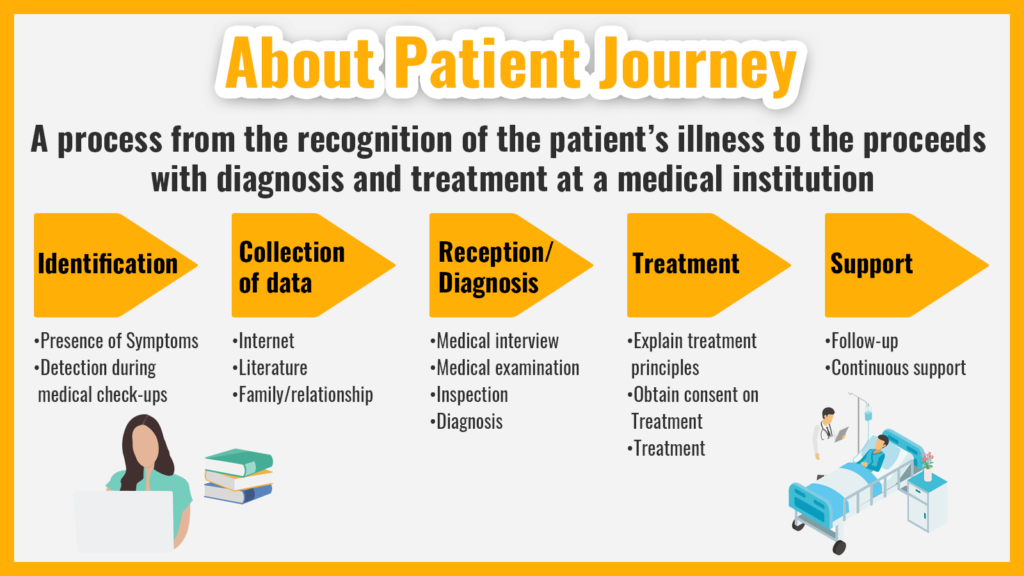Patient Journey; the merits of mapping, its meaning and value
Do you know what the patient journey means? Even if you have heard the words, you may not know their specific meaning, necessity, or how to use it.
In this article, we explain the meaning and necessity of the patient journey, as well as why it contributes to healthcare marketing. Also, we have summarized the benefits of creating a patient journey map, so we hope it will be resourceful.
PATIENT JOURNEY

The name “Patient Journey” is self-explicit, the term conveys the evolution of the patient’s status from the discovery of the illness throughout the treatment and the evolution of the patient’s health status.
“Patient’s Journey” refers to a tool for grasping the overall picture of how patients feel, think, and act in the process of recognizing a disease and proceeding with diagnosis and treatment at medical institutions.
The patient journey can be divided into five stages:
- Recognition
- Data Collection
- Consultation & Diagnosis
- Treatment
- Support
The patient journey begins with the patient becoming ill and acting upon the illness. In addition to researching their own symptoms on the Internet and in books, patients also gather information by consulting with family members and acquaintances. After that, based on the information collected, the patient will visit a medical institution to examine the symptoms.
After visiting a medical institution, a doctor will make a diagnosis based on the results of interviews, examinations, and tests performed by medical professionals. The doctor tells the patient the name of the disease and the treatment method, obtains the patient’s consent, and begins treatment. After the treatment, it is a series of follow-up, evaluation and explanation of the treatment, and continuous follow-up.
The 5 Steps of the Patient Journey
As mentioned above, the patient journey can be divided into five stages: recognition, information gathering, consultation / diagnosis, treatment, and follow-up. Below, we delve deeper into the five stages of the patient journey and how patients behave at each stage.
1. Cognition
The beginning of the patient journey coincides with recognizing the disease. There are two ways that patients perceive their illness:
- Symptoms
- If an abnormality is found in the health checkup
There are two patterns: when patients notice the disease due to symptoms such as discomfort and pain, and when patients receive feedback from health checkup. Patients do not know much about their disease and are anxious.
2. Information gathering
After recognizing the disease, the patient collects information. There are four main methods of collecting information.
- Internet
- Books
- Blogs
- Social Media
Patients search the Internet or look up books to find out the names of diseases and hospitals related to their symptoms. In recent years, there are websites where you can search for the name of the disease and the appropriate doctor by entering your symptoms on the Internet, so it seems that more people search online than in books.
In addition, we observe new ways of collecting information by looking at blogs and SNS, to learn from the struggles of patients with the same symptoms and diseases. Patients may become more anxious by researching their symptoms and disorders on their own.
3. Consultation / Diagnosis
It is the pivotal phase with the visit of a medical institution to undergo a medical examination and consultation.
- Interview
- Consultation
- Tests
- Notification of diagnosis results
- Explanation of treatment approach
The patient undergoes an examination at a medical institution and hears the diagnosis result from the doctor. Then, after receiving an explanation of the treatment policy, consent is given and treatment will start.
Even in the case of a completely cured disease, patients have great anxiety about future treatment and fighting against the disease. If the disease is more advanced or severe than expected, it may not be accepted. It is important for healthcare professionals to empathize with patients and respect their opinions.
4. Treatment
Treatments vary depending on the disease. For example, there are four cancer treatments:
- Surgical therapy
- Drug (chemo) therapy
- Radiation therapy
- Immunotherapy
Patients look up a variety of information about treatment, such as, “What treatments are available?”, “Which treatment is best?” Some patients may consider getting a second opinion to expand their options.
5. Follow-up
After treatment, we will evaluate the treatment and follow up with the patient. Its contents are as follows.
- Evaluation of treatment
- Explanation of treatment evaluation to patients
- Continuous observation of the patients
- Continuous treatment until complete recovery or follow-up at the end of life
After treatment, an evaluation is performed and is communicated to the patient. If further treatment is necessary until complete recovery, explain to the patient and continue treatment. End-of-life care is provided if no further treatment is available.
Patients who have been treated successfully and can see the path to complete recovery will be even more delighted. Patients who are incurable may accept the time to live or search for other treatments on their own. Healthcare professionals respect the patient’s opinion and continue to follow up.
The benefits of creating a patient journey map
The benefits of creating a patient journey map are:
- Understanding the patient’s thoughts
- Understanding the patient’s behavior deepens by understanding the patient’s thoughts
- By sharing patient journey maps, it is possible to unify the opinions of the main stakeholders
A patient journey map is a very effective tool for a deeper understanding of patients.
Medical care provided by medical institutions may result in one-sided treatment and misunderstandings with patients. Without good communication, it will be difficult to build trust. By using the Patient Journey Map, every stakeholder understands why patients think and act accordingly, and can provide patient-first medical care.
In addition, it is possible to share a common understanding of the treatment flow not only among medical professionals but also with pharmaceutical companies that provide pharmaceuticals.
Need for Patient Journey
Patient journeys play a key role in helping healthcare organizations deliver patient-centered care. Patient Journey enables us to understand the patient’s way of thinking, feeling, and behavior during the process from the onset to examination, diagnosis, treatment, recovery and end of life. It also serves as an opportunity to learn about the latent needs of patients. Understanding the patient’s feelings and supporting decision-making will increase the trust between the patient and the medical institution.
The patient journey also plays an important role in pharmaceutical companies, medical device manufacturers, and medical material manufacturers. Unlike medical professionals, healthcare manufacturers have very few opportunities to come into contact with patients. But the Patient Journey allows them to get to know patients without having to interact directly with them. It should make possible a more patient-centered product strategy, rather than just looking at symptoms and test values and applying them to products.
The patient journey leads to marketing
The Patient Journey makes it easy to understand the patient’s emotional movements and accompanying behaviors, leading to hints for product strategy.
Literature provides an overview of the disease and symptoms, but not the real voices of patients. For example, suppose there were only oral medications for a disease. However, when I saw Patient Journey and realized that “not only food, but also water is difficult to pass through my throat”, I came up with the idea that “I need to develop a drug with a different route of administration”. A deep understanding of the patient enables development to be patient-first rather than development-led.
The Patient Journey can be said to be a useful tool not only for medical professionals, but also for pharmaceutical companies, medical device manufacturers, and medical material manufacturers that develop and sell products.
Summary
Patient Journey is a tool that allows you to visually grasp the overall picture of the process of diagnosis and treatment at medical institutions and how patients feel, think, and act. In providing patient-first treatment, not only medical professionals, but also pharmaceutical companies and medical device manufacturers place importance on it.
Medical Data Vision Co., Ltd. provides “MDV analyzer for Patient Journey,” which allows you to easily check on the web the treatment flow for the target disease. Our “MDV analyzer for Patient Journey” utilizes the largest clinical database in Japan, allowing you to visually check the patient’s treatment flow with a Sankey diagram. It can be used in a wide range of applications, such as market research for marketing, feasibility research during clinical trials, and preparation of evaluation materials for introduced products.
If you are considering using Patient Journey, please feel free to contact us.
For More Information, Please Contact Us Here
About Japanese Healthcare System

What you need to know about the healthcare system in Japan before using the data.
SERVICE

In addition to various web tools that allow you to easily conduct surveys via a browser using our medical database, we offer data provision services categorized into four types to meet your needs and challenges: "Analysis reports" "Datasets," "All Therapeutic Areas Data Provision Service," and "Specific Therapeutic Areas Data Provision Service.

© Medical Data Vision Co., Ltd. All Rights Reserved.





